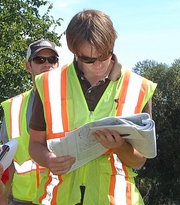The U.S. Occupational Safety and Health Administration (OSHA) is big on “good faith.”
In business law, “good faith” basically means a genuine intention to deal fairly with others in commercial transactions. When OSHA compliance officers show up at a jobsite to do an inspection, their idea of good faith is a clear effort by the company to be safe.
 Even if violations are found, a good faith effort to be safe can lessen the penalties. This isn’t some unwritten rule. In its guide to OSHA inspections, the agency unambiguously states: “OSHA may adjust a penalty for a serious violation downward based on the employer’s good faith.”
Even if violations are found, a good faith effort to be safe can lessen the penalties. This isn’t some unwritten rule. In its guide to OSHA inspections, the agency unambiguously states: “OSHA may adjust a penalty for a serious violation downward based on the employer’s good faith.”
If OSHA inspectors arrive with little or no warning, as they usually do, one very effective way you can demonstrate this good faith is by showing that you systematically insist on regular safety inspections of critical facilities, equipment, and processes.
Why (and How) OSHA Inspects
OSHA doesn’t have enough compliance officers to inspect every business, so they set priorities in this order:
1. Imminent danger—If OSHA becomes aware of hazards that could cause immediate death or serious injury, they will be onsite ASAP to have the hazards fixed or operations stopped.
2. Fatalities and catastrophes—Businesses must report hospitalizations of three or more employees or any death to OSHA within eight hours of the incident, and OSHA will come to investigate.
3. Complaints—Personnel can file anonymous complaints that trigger site inspections.
4. Referrals—Other federal, state, or local agencies (or the media!) can contact OSHA and recommend an inspection.
5. Follow-ups—In some cases, OSHA will return to ensure violations have been abated.
6. Planned or programmed investigations—Lastly, OSHA targets specific industries or individual businesses that have a history of high injury and illness rates.
When OSHA decides to inspect, they aren’t required to give notice, and even if they do, it’s usually less than 24 hours. OSHA inspectors aren’t stupid; they want to check the workplace without giving unscrupulous businesses time to temporarily hide problems.
A Proactive Inspection Program Show Sincerity
OSHA is used to catching businesses with their “pants down,” so when they show up and you can immediately provide evidence of regular inspections—beyond what’s required by law—they know you’re serious about safety and not just running around posting up the required OSHA signs at the last minute.
You’re showing them the “good faith” that will mitigate any violations the OSHA inspectors might find. In fact, OSHA may not even penalize you if you’ve shown good faith and immediately fix minor violations.
But they’re not going to take your word for it. You have to be able to provide actual documentation to prove that you have a solid, proactive inspection program in place. That’s one of the many benefits of The Checker—whether you’re using paper or our mobile solution, the documentation is in one place, organized for easy retrieval and review.
“We use The Checker” is the right thing to say when you have an OSHA inspector at your door!
Image courtesy of U.S. Corps of Engineers, Creative Commons.










